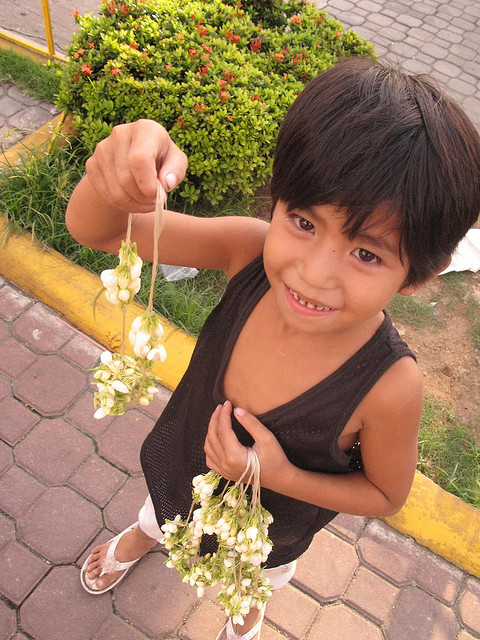When traveling around Manila, it's not very unusual to see young children walking barefoot in the streets or on the sidewalk selling cigarettes, candy, tabloids and sampaguitas. Their skin is deeply tanned by the hot sun, their tattered clothing is often dirty and their hair is in messy tangles. At times, there would be one older child carrying his or her younger sibling while begging for whatever change passers-by and vehicle owners would spare.
Why is this? More often than not, child labor is the result of poverty. According to the National Statistics Office, 3.6 million Filipino children, aged 5-17, are child laborers. When the parents just don't have enough money to make ends meet they usually force their children out of school and send them to work out on the streets, haciendas or factories. Earning money for their food and shelter became their sole purpose, no longer the education that should have served to bring them a better future.
There are also times when these children were orphaned. The eldest child takes on the responsibility of the parents and, again, drops out of school to provide for his or her younger siblings in the hopes of giving them the education that he or she was deprived of.
Then again, the reason could be an even worse one. There are instances when these children are children of irresponsible parents who, instead of working and earning a living for their children, laze around and expect their daily bread to come from the earnings of the child or children that they'd sent out to sell many different goods and possibly, in more unfortunate cases, their bodies. After all this hard work and degradation, it's actually possible that the money they earned would be used to pay off a debt in gambling or be squandered on beer and other alcoholic drinks.
Children from the ages 5 to about 17 are usually the ones found laboring under the hot sun or behind machines for small companies or syndicates. This figure alone comprises roughly 15.9% of the total Philippine population or one out of six children. In a breakdown, 216,000 are within 5-9 years old, 1.6 million for the 10-14 group and 1.8 million are 15-17 years old.
Some children are syndicate slaves, they have been kidnapped or bought from their families. Some children are hired because they can be paid a lot less than the minimum wage, they require less food intake, tire less easily and they have no need to apply for such things as medical plans, SSS (Social Security System) or retirement. Tasks like carrying heavy cement bags are assigned to these children because they are said to be stronger anyway, so why not? The truth of the matter is, with all this hard work, low pay and lack of a medical plan, they become weaker and weaker, eventually causing them to lose their job and their income. The result of this is either their younger siblings are forced to work, or the whole family suffers from starvation.
What is the government doing about this? There have been bills passed regarding this issue, but the implementation of taking these children off the streets and into school has not been successful. To them, their education is less important than their family's survival. In the future however, perhaps there could be something done about this, maybe even forcing these children's parents to find a job instead of spending the hours of the day sitting at home watching television or gambling.
Among the 3.6 million working Filipino children, 20.7% are in rural, and 11.5% urban areas. Most rural males work in farms while girls tend to be confined within the realm of household chores. The rest are found in an employer’s household, the marketplace, fisheries, mines and quarries, and factories.

















1 comments:
I liked your post and I am waiting for your new update excellent platform for sharing your knowledge with others Thanksgiving Outfits
Post a Comment